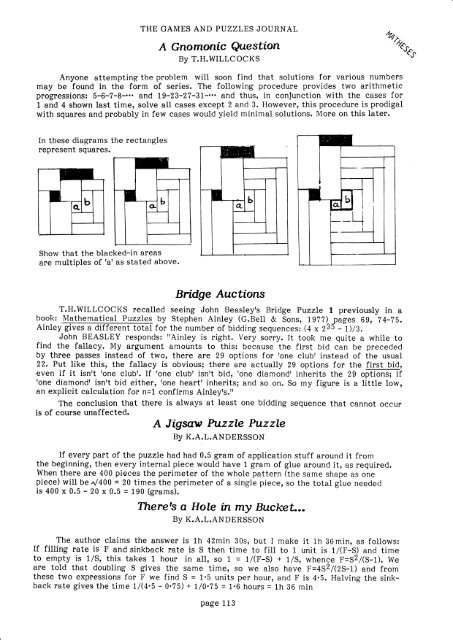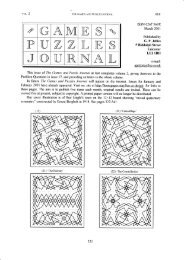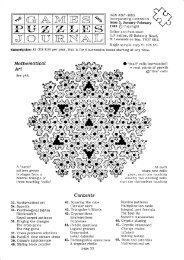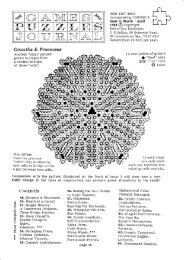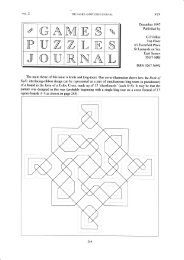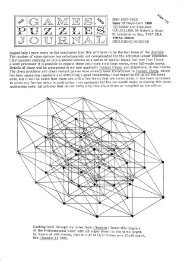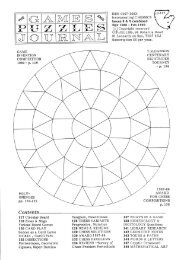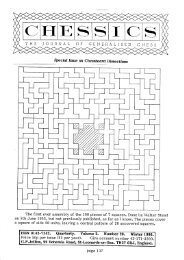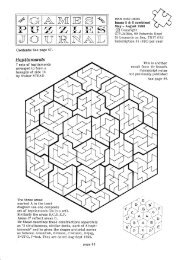The Games and Puzzles Journal, #7 - Mayhematics
The Games and Puzzles Journal, #7 - Mayhematics
The Games and Puzzles Journal, #7 - Mayhematics
You also want an ePaper? Increase the reach of your titles
YUMPU automatically turns print PDFs into web optimized ePapers that Google loves.
THE GAMES AND PUZZLES JOURNALA Gnomonic QuesflonBy T.H.WILLCOCKSo\Anyone attempting the problem will soon find that solutions for various numbersmay be found in the form of series. <strong>The</strong> following procedure provides two arithmeticprogressions: 5-6-?-8-... <strong>and</strong> L9-23-27-31-". <strong>and</strong> thus, in conJunction with the cases for1 <strong>and</strong> 4 shown last time, solve all cases except 2 <strong>and</strong> 3. However, this procedure is prodigalwith squares <strong>and</strong> probably in few cases would yield minimal solutions. More on this later.In these diagrams the rectanglesrepresent squares.Show that the blacked-in areasare multiples of rat as stated above.Brtdge AuctionsT.H.WILLCOCKS recalled seeing John Beasley's Bridge Puzzle I previously in abook: N1athematig.L*puzzles. by Stephen Ainley (G.gett & Sons, tgzz) pages 69,74-75,einey@fortnenumberoruiocingSequences,(a*z36-.D/l,John BEASLEY responds: "Ainley is right. Very sorry. It took me quite a while tofind the fallacy. My argument amounts to this: because the first bid can be precededby three passes instead of two, there are 29 options for 'one clubt instead of the usual22, Put like this, the fallacy is obvious; there are actually 29 options for the first bid,even if it isntt 'one club'. If 'one clubt isntt bid, rone diamondr inherits the 29 oplloi$l?fone diamondr isn't bid either, rone heartr inherits; <strong>and</strong> so on. So my figure is a little low,an explieit calculation for n=1 confirms Ainleyts."<strong>The</strong> conclusion that there is always at least one bidding sequence that cannot occuris of course unaffected.A Jrgscru h,tzzle PuzzleBy K.A.L.ANDERSSONIf every part of the puzzle had had 0.5 gram of application stuff around it fromthe beginning, then every internal piece would have 1 gram of glue around it, as required.When there are 400 pieces the perimeter of the whole pattern (the same shape as onepiece) will be 4400 = 20 times the perimeter of a single piece, so the total glue neededis 400 x 0.5 - 20 x 0.5 = 190 (grams).<strong>The</strong>rets a Hole in my BttckeL..By K.A.L.ANDERSSON<strong>The</strong> author claims the answer is th 42min 30s, but I make it th 36min, as follows:If filling rate is F <strong>and</strong> sinkback rate is S then time to fill to 1 unit is l/(F-S) <strong>and</strong> timeto empty is 1/S, this takes t hour in all, so I = 1/(F-S) + 1/S, whence F=S2I(S-1). Weare told that doubling S gives the same time, so we also have F=4S2I(ZS-1) <strong>and</strong> fromthese two expressions for F we find S = 1.5 units per hour, <strong>and</strong> F is 4.5. Halving the sinkbackrate gives the time L/(4.5 - 0.75) + l/0.75 = 1.6 hours = th 36 minpage 1. L 3


